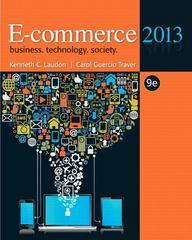Question
A consumer acquires bundles of two goods that we will call A and B. Let's denote the quantities by the letters A and B. In
A consumer acquires bundles of two goods that we will call "A" and "B". Let's denote the quantities by the letters A and B. In fact, the consumer is observed to buy quanties in such a way that A = B. From her behavior is clear that to have more of any of the goods than of the other doesn't improve utility. (Formally utility is U = min{A, B})
a. What types of goods are these? Represent her preferences using the xaxis for A and the yaxisfor B.
b .Give an example of a pair of goods that have the relationship you stated in a (e.g. coffees and donuts in a given period of time).
c . Call Pathe price of the first good and Pb the price of the second good. Suppose that the consumer has a monthly income Y. Derive the equations for: 1) the demand of A, 2) the demand of B, 3) the Engel curve of A, 4) the Engel curve of B. Explain intuitively the meaning of each.
d. Choose any numbers you like for Pa and Pb. Fix Y = 100. At the prices you have chosen, what are the demands for A and B? Next, raise the price Pa leaving Pband leaving Y unchanged. What are the demands for A and B now? Graph both equilibriums.
e. Describe the substitution and the income effects corresponding to d.
f (Label your indifference curves. How does the utility change?
Step by Step Solution
There are 3 Steps involved in it
Step: 1

Get Instant Access to Expert-Tailored Solutions
See step-by-step solutions with expert insights and AI powered tools for academic success
Step: 2

Step: 3

Ace Your Homework with AI
Get the answers you need in no time with our AI-driven, step-by-step assistance
Get Started


